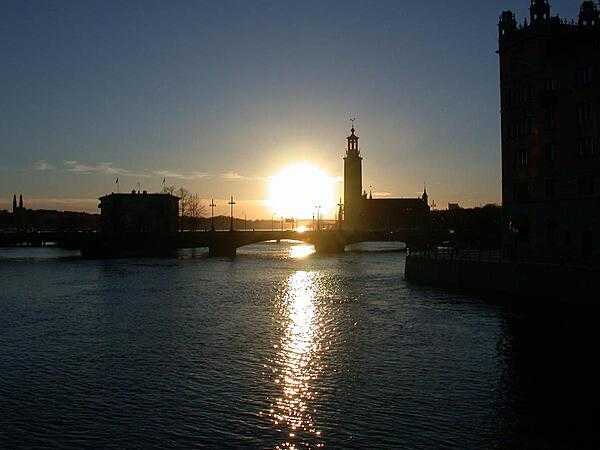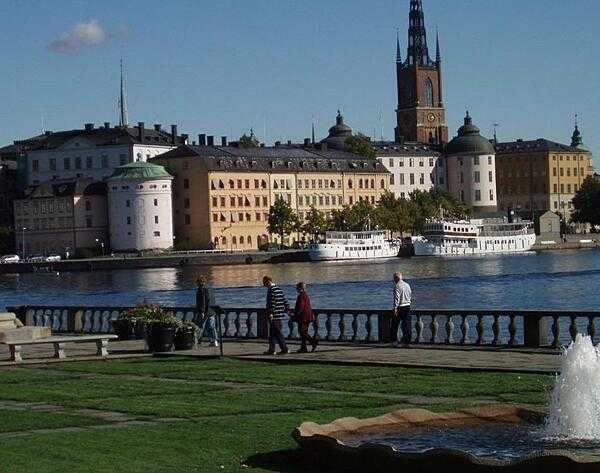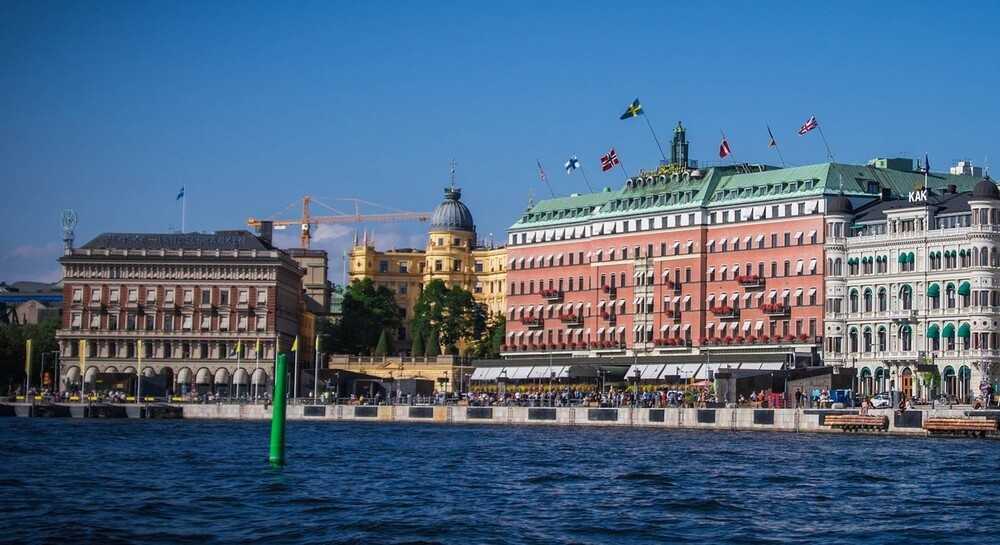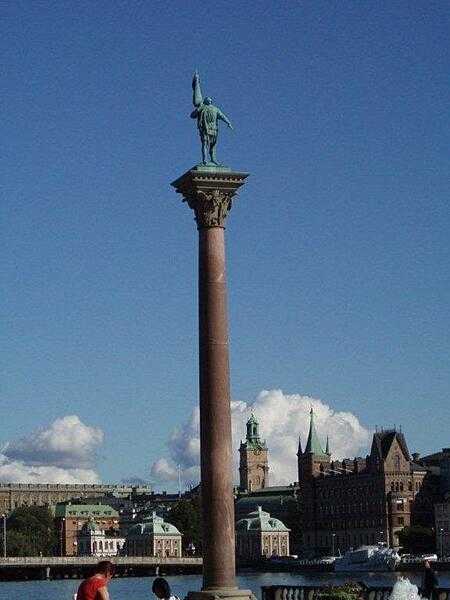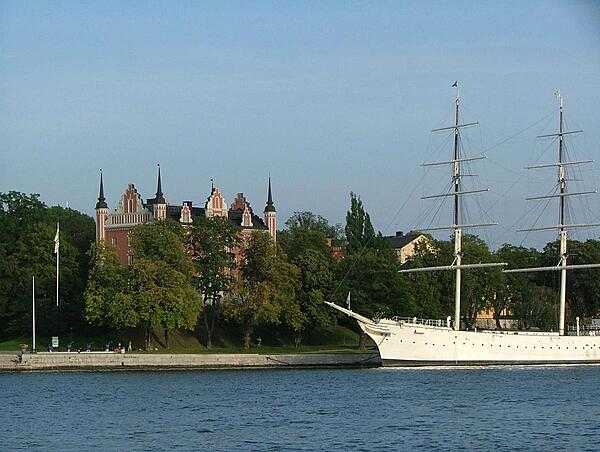Sweden - SE - SWE - SWE - Europe

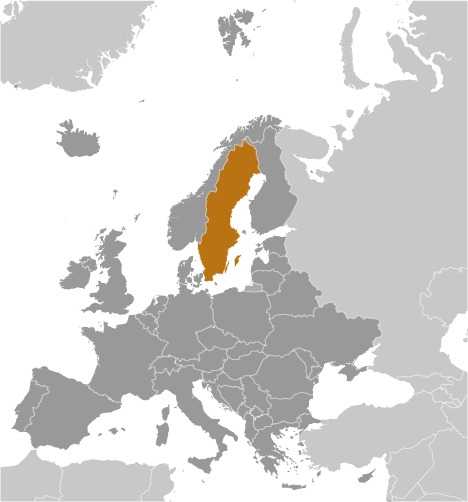
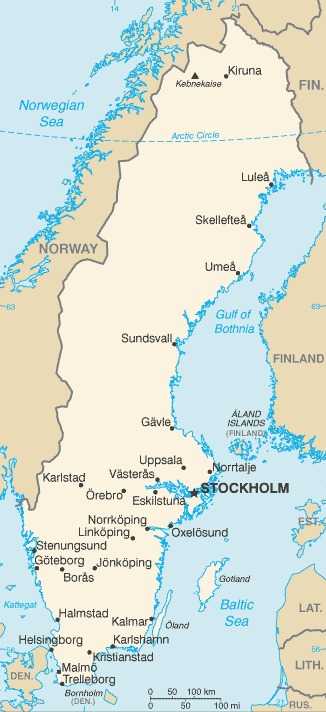
Sweden Images
Sweden Factbook Data
Diplomatic representation from the US
embassy: Dag Hammarskjolds Vag 31, SE-115 89 Stockholm
mailing address: 5750 Stockholm Place, Washington, DC 20521-5750
telephone: [46] (08) 783-53-00
FAX: [46] (08) 661-19-64
email address and website:
STKACSinfo@state.gov
https://se.usembassy.gov/
Age structure
15-64 years: 62.1% (male 3,365,754/female 3,208,248)
65 years and over: 20.8% (2024 est.) (male 1,032,279/female 1,168,576)

For additional information, please see the entry for Population pyramid on the Definitions and Notes page.
Geographic coordinates
Sex ratio
0-14 years: 1.06 male(s)/female
15-64 years: 1.05 male(s)/female
65 years and over: 0.88 male(s)/female
total population: 1.01 male(s)/female (2024 est.)
Natural hazards
Area - comparative
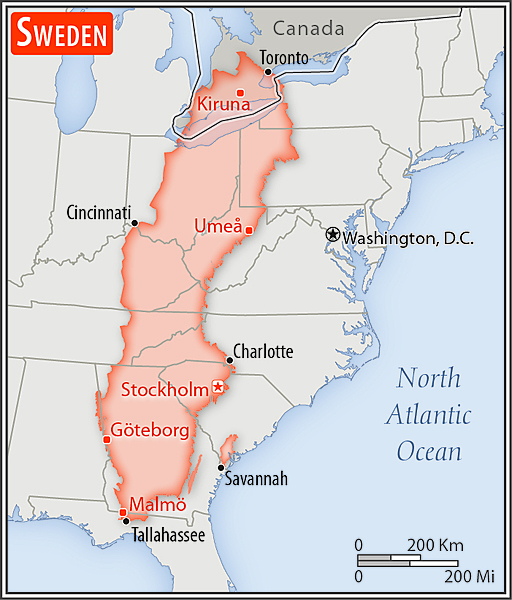
almost three times the size of Georgia; slightly larger than California
Military service age and obligation
note 1: Sweden conscripts about 5,500 men and women each year; it plans to increase this number to 8,000 by 2025; conscientious objectors in Sweden have the right to apply for alternative service (called vapenfri tjänst); after completing alternative service, the conscript then belongs to the civilian reserve
note 2: as of 2024, women made nearly 25% of the military's personnel
Background
A military power during the 17th century, Sweden maintained a policy of military non-alignment until it applied to join NATO in 2022. Sweden has not participated in any war for two centuries. Stockholm preserved an armed neutrality in both World Wars. Since then, Sweden has pursued a successful economic formula consisting of a capitalist system intermixed with substantial welfare elements. Sweden joined the EU in 1995, but the public rejected the introduction of the euro in a 2003 referendum. The share of Sweden’s population born abroad increased from 11.3% in 2000 to 20% in 2022.
Environmental issues
International environmental agreements
signed, but not ratified: none of the selected agreements
Military expenditures
2.3% of GDP (2024 est.)
1.7% of GDP (2023 est.)
1.5% of GDP (2022 est.)
1.4% of GDP (2021 est.)
Population below poverty line
note: % of population with income below national poverty line
Household income or consumption by percentage share
highest 10%: 24.7% (2022 est.)
note: % share of income accruing to lowest and highest 10% of population
Exports - commodities
note: top five export commodities based on value in dollars
Exports - partners
note: top five export partners based on percentage share of exports
Administrative divisions
Agricultural products
note: top ten agricultural products based on tonnage
Military and security forces
Budget
expenditures: $191.095 billion (2022 est.)
note: central government revenues (excluding grants) and expenditures converted to US dollars at average official exchange rate for year indicated
Capital
geographic coordinates: 59 20 N, 18 03 E
time difference: UTC+1 (6 hours ahead of Washington, DC, during Standard Time)
daylight saving time: +1hr, begins last Sunday in March; ends last Sunday in October
etymology: the name of the city probably comes from the Swedish words stak (bay) or stock (stake or pole) and holm (island); it was built in the mid-13th century on the site of a fishing village, so the name may refer to building over earlier foundations
Imports - commodities
note: top five import commodities based on value in dollars
Climate
Coastline
Constitution
amendment process: proposed by Parliament; passage requires simple majority vote in two consecutive parliamentary terms with an intervening general election; passage also requires approval by simple majority vote in a referendum if Parliament approves a motion for a referendum by one third of its members; the results of such a referendum are only binding if a majority vote against the proposal
Exchange rates
Exchange rates:
10.568 (2024 est.)
10.61 (2023 est.)
10.114 (2022 est.)
8.577 (2021 est.)
9.21 (2020 est.)
Executive branch
head of government: Prime Minister Ulf KRISTERSSON (since 18 October 2022)
cabinet: Cabinet appointed by the prime minister
election/appointment process: the monarchy is hereditary; following legislative elections, the leader of the majority party or majority coalition usually becomes the prime minister
Flag
meaning: the colors come from the Swedish coat of arms
Independence
Industries
Judicial branch
judge selection and term of office: Supreme Court and Supreme Administrative Court justices nominated by the Judges Proposal Board, a 9-member nominating body consisting of high-level judges, prosecutors, and members of Parliament; justices appointed by the government; after a probationary period, justices' appointments are permanent
subordinate courts: first instance, appellate, general, and administrative courts; specialized courts that handle cases such as land and environment, immigration, labor, markets, and patents
Land boundaries
border countries (2): Finland 545 km; Norway 1,666 km
Land use
arable land: 6.2% (2023 est.)
permanent crops: 0% (2023 est.)
permanent pasture: 1.1% (2023 est.)
forest: 68.6% (2023 est.)
other: 23.8% (2023 est.)
Legal system
Legislative branch
legislative structure: unicameral
number of seats: 349 (all directly elected)
electoral system: proportional representation
scope of elections: full renewal
term in office: 4 years
most recent election date: 9/11/2022
parties elected and seats per party: Social Democratic Party (SAP) (107); Sweden Democrats (SD) (73); Moderate Party (M) (68); Left Party (VP) (24); Centre Party (CP) (24); Christian Democrats (KD) (19); Green Party (Mpg) (18); Other (16)
percentage of women in chamber: 45%
expected date of next election: September 2026
Maritime claims
exclusive economic zone: agreed boundaries or midlines
continental shelf: 200-m depth or to the depth of exploitation
International organization participation
National holiday
note: celebrated as Swedish Flag Day from 1916 to 1982
Nationality
adjective: Swedish
Natural resources
Geography - note
Economic overview
high-income, largest Nordic economy; EU member but does not use the euro; export-oriented, led by automotive, electronics, machinery, and pharmaceuticals; highly ranked for competitiveness, R&D investments and governance; recovery, with falling inflation and real wage growth balanced by risks from trade uncertainty
Political parties
Christian Democrats (Kristdemokraterna) or KD
Green Party (Miljopartiet de Grona) or MP
Left Party (Vansterpartiet) or V
Moderate Party (Moderaterna) or M
Sweden Democrats (Sverigedemokraterna) or SD
Swedish Social Democratic Party (Socialdemokraterna) or S/SAP
The Liberals (Liberalerna) or L
Railways
narrow gauge: 65 km
Suffrage
Terrain
Government type
Country name
conventional short form: Sweden
local long form: Konungariket Sverige
local short form: Sverige
etymology: name derives from the North Germanic Svea tribe that inhabited central Sweden; the tribe's name probably comes from the Old German word sweba, meaning "independent;" the local form of the country's name, Sverige, means "kingdom of the Svea"
Location
Map references
Irrigated land
Diplomatic representation in the US
chancery: 2900 K Street NW, Washington, DC 20007
telephone: [1] (202) 467-2600
FAX: [1] (202) 467-2699
email address and website:
ambassaden.washington@gov.se
https://www.swedenabroad.se/en/embassies/usa-washington/
consulate(s) general: New York, San Francisco
Internet users
Internet country code
Refugees and internally displaced persons
stateless persons: 6,835 (2024 est.)
GDP (official exchange rate)
note: data in current dollars at official exchange rate
Total renewable water resources
School life expectancy (primary to tertiary education)
male: 17 years (2023 est.)
female: 20 years (2023 est.)
Urbanization
rate of urbanization: 0.89% annual rate of change (2020-25 est.)
Broadcast media
Drinking water source
urban: 99.8% of population (2022 est.)
rural: 99.6% of population (2022 est.)
total: 99.7% of population (2022 est.)
unimproved:
urban: 0.2% of population (2022 est.)
rural: 0.4% of population (2022 est.)
total: 0.3% of population (2022 est.)
National anthem(s)
lyrics/music: Richard DYBECK/traditional
history: in use since 1893; also known as "Sang till Norden" (Song of the North); based on a Swedish folk tune; has never been officially adopted
_____
title: "Kungssangen" (Royal Song)
lyrics/music: Carl Wilhelm August Strandberg/Otto Lindblad
history: adopted 1844 as the royal anthem, but also used as the national anthem until 1893; only the first verse is sung if the monarch is present
Major urban areas - population
International law organization participation
Physician density
Hospital bed density
National symbol(s)
Mother's mean age at first birth
GDP - composition, by end use
government consumption: 26% (2023 est.)
investment in fixed capital: 25% (2023 est.)
investment in inventories: -0.1% (2023 est.)
exports of goods and services: 55.4% (2023 est.)
imports of goods and services: -51.4% (2023 est.)
note: figures may not total 100% due to rounding or gaps in data collection
Dependency ratios
youth dependency ratio: 27.6 (2024 est.)
elderly dependency ratio: 33.5 (2024 est.)
potential support ratio: 3 (2024 est.)
Citizenship
citizenship by descent only: the father must be a citizen of Sweden; in the case of a child born out of wedlock, the mother must be a citizen of Sweden and the father unknown
dual citizenship recognized: no, unless the other citizenship was acquired involuntarily
residency requirement for naturalization: 5 years
Population distribution
Electricity access
Civil aircraft registration country code prefix
Sanitation facility access
urban: 99.6% of population (2022 est.)
rural: 99.5% of population (2022 est.)
total: 99.6% of population (2022 est.)
unimproved:
urban: 0.4% of population (2022 est.)
rural: 0.5% of population (2022 est.)
total: 0.4% of population (2022 est.)
Ethnic groups
Swedish 79.6%, Syrian 1.9%, Iraqi 1.4%, Finnish 1.3%, other 15.8%
(2022 est.)note: data represent the population by country of birth; the indigenous Sami people are estimated to number between 20,000 and 40,000
Religions
note: estimates reflect registered members of faith communities eligible for state funding (not all religions are state-funded and not all people who identify with a particular religion are registered members) and the Church of Sweden
Languages
major-language sample(s):
The World Factbook, den obestridliga källan för grundläggande information. (Swedish)
The World Factbook, the indispensable source for basic information.
note: Finnish, Sami, Romani, Yiddish, and Meankieli are official minority languages
Imports - partners
note: top five import partners based on percentage share of imports
Elevation
lowest point: reclaimed bay of Lake Hammarsjon, near Kristianstad -2.4 m
mean elevation: 320 m
Health expenditure
19% of national budget (2022 est.)
Military - note
Sweden maintained a policy of military non-alignment for over 200 years before applying for NATO membership in May 2022 following Russia’s full-scale invasion of Ukraine; it became a NATO member in March 2024; prior to membership, Stockholm joined NATO’s Partnership for Peace program in 1994 and contributed to NATO-led missions, including those in Afghanistan, Iraq, and Kosovo; the military cooperates closely with the forces of other Nordic countries through the Nordic Defense Cooperation (NORDEFCO; established 2009), which consists of Denmark, Finland, Iceland, Norway, and Sweden; Sweden is a signatory of the EU’s Common Security and Defense Policy (CSDP) and contributes to CSDP missions and operations, including EU battlegroups; it also participates in UN-led missions; Sweden has close bilateral security relations with some individual NATO member states, particularly Finland, Germany, Norway, the UK, and the US (2025)
Military and security service personnel strengths
note 1: SAF personnel are divided into continuously serving (full-time) and temporary service troops (part-timers who serve periodically and have another main employer or attend school); additional personnel have signed service agreements with the SAF and mostly serve in the Home Guard
note 2: in 2021, Sweden announced plans that increase the total size of the armed forces to about 100,000 personnel by 2030
Military deployments
Terrorist group(s)
note: details about the history, aims, leadership, organization, areas of operation, tactics, targets, weapons, size, and sources of support of the group(s) appear(s) in the Terrorism reference guide
Total water withdrawal
industrial: 1.267 billion cubic meters (2022 est.)
agricultural: 102 million cubic meters (2022 est.)
Waste and recycling
percent of municipal solid waste recycled: 39.7% (2022 est.)
Average household expenditures
on alcohol and tobacco: 3.1% of household expenditures (2023 est.)
Major lakes (area sq km)
National heritage
selected World Heritage Site locales: Royal Domain of Drottningholm (c); Laponian Area (m); High Coast/Kvarken Archipelago (n); Birka and Hovgården (c); Hanseatic Town of Visby (c); Church Town of Gammelstad, Luleå (c); Naval Port of Karlskrona (c); Rock Carvings in Tanum (c); Engelsberg Ironworks (c); Mining Area of the Great Copper Mountain in Falun (c)
Coal
consumption: 3.17 million metric tons (2023 est.)
exports: 23,000 metric tons (2023 est.)
imports: 2.078 million metric tons (2023 est.)
proven reserves: 5 million metric tons (2023 est.)
Electricity generation sources
nuclear: 28.6% of total installed capacity (2023 est.)
solar: 1.9% of total installed capacity (2023 est.)
wind: 21% of total installed capacity (2023 est.)
hydroelectricity: 40.2% of total installed capacity (2023 est.)
biomass and waste: 7.8% of total installed capacity (2023 est.)
Natural gas
exports: 10.625 million cubic meters (2023 est.)
imports: 897.487 million cubic meters (2023 est.)
Petroleum
refined petroleum consumption: 270,000 bbl/day (2024 est.)
Currently married women (ages 15-49)
Remittances
0.7% of GDP (2023 est.)
0.6% of GDP (2022 est.)
note: personal transfers and compensation between resident and non-resident individuals/households/entities
Nuclear energy
Net capacity of operational nuclear reactors: 7.01GW (2025 est.)
Percent of total electricity production: 28.6% (2023 est.)
Number of nuclear reactors permanently shut down: 7 (2025)
Space program overview
Space launch site(s)
Space agency/agencies
Geoparks
global geoparks and regional networks: Platåbergens (2023)
Ports
large: 3
medium: 10
small: 30
very small: 49
ports with oil terminals: 49
key ports: Falkenberg, Goteborg, Helsingborg, Karlsborg, Karlshamn, Lulea, Malmo, Norrkoping, Stockholm, Sundsvall, Uddevalla, Varberg, Vasteras
National color(s)
Particulate matter emissions
Methane emissions
agriculture: 127.8 kt (2019-2021 est.)
waste: 112.7 kt (2019-2021 est.)
other: 9.8 kt (2019-2021 est.)
Key space-program milestones
1961 - launched first sounding rocket
1986 - first scientific satellite (Viking) launched on European rocket
1989 - first communications satellite (Tele-X) launched on European rocket
2006 - first astronaut into space on US Space Shuttle
2019 - established a space data lab for artificial intelligence-based analysis of imagery data
2024 - signed US-led Artemis Accords for space and lunar exploration; launched first military communications satellite (GNA-3); adopted its first defense and security space strategy
Labor force
note: number of people ages 15 or older who are employed or seeking work
Youth unemployment rate (ages 15-24)
male: 24.3% (2024 est.)
female: 23.2% (2024 est.)
note: % of labor force ages 15-24 seeking employment
Maternal mortality ratio
Reserves of foreign exchange and gold
$60.863 billion (2023 est.)
$64.289 billion (2022 est.)
note: holdings of gold (year-end prices)/foreign exchange/special drawing rights in current dollars
Public debt
note: central government debt as a % of GDP
Unemployment rate
7.7% (2023 est.)
7.4% (2022 est.)
note: % of labor force seeking employment
Population
male: 5,332,701
female: 5,257,134
Carbon dioxide emissions
from coal and metallurgical coke: 5.324 million metric tonnes of CO2 (2023 est.)
from petroleum and other liquids: 36.768 million metric tonnes of CO2 (2023 est.)
from consumed natural gas: 1.868 million metric tonnes of CO2 (2023 est.)
Area
land: 410,335 sq km
water: 39,960 sq km
Taxes and other revenues
note: central government tax revenue as a % of GDP
Real GDP (purchasing power parity)
$662.18 billion (2023 est.)
$662.937 billion (2022 est.)
note: data in 2021 dollars
Airports
Gini Index coefficient - distribution of family income
note: index (0-100) of income distribution; higher values represent greater inequality
Inflation rate (consumer prices)
8.5% (2023 est.)
8.4% (2022 est.)
note: annual % change based on consumer prices
Current account balance
$40.819 billion (2023 est.)
$27.404 billion (2022 est.)
note: balance of payments - net trade and primary/secondary income in current dollars
Real GDP per capita
$62,800 (2023 est.)
$63,200 (2022 est.)
note: data in 2021 dollars
Broadband - fixed subscriptions
subscriptions per 100 inhabitants: 41 (2023 est.)
Tobacco use
male: 25.8% (2025 est.)
female: 13.9% (2025 est.)
Obesity - adult prevalence rate
Energy consumption per capita
Electricity
consumption: 125.273 billion kWh (2023 est.)
exports: 36.151 billion kWh (2023 est.)
imports: 7.335 billion kWh (2023 est.)
transmission/distribution losses: 9.109 billion kWh (2023 est.)
Merchant marine
by type: general cargo 44, oil tanker 18, other 299
Imports
$304.194 billion (2023 est.)
$304.101 billion (2022 est.)
note: balance of payments - imports of goods and services in current dollars
Exports
$329.332 billion (2023 est.)
$318.203 billion (2022 est.)
note: balance of payments - exports of goods and services in current dollars
Heliports
Telephones - fixed lines
subscriptions per 100 inhabitants: 9 (2023 est.)
Alcohol consumption per capita
beer: 2.6 liters of pure alcohol (2019 est.)
wine: 3.4 liters of pure alcohol (2019 est.)
spirits: 1 liters of pure alcohol (2019 est.)
other alcohols: 0.1 liters of pure alcohol (2019 est.)
Life expectancy at birth
male: 81.2 years
female: 84.7 years
Real GDP growth rate
-0.1% (2023 est.)
1.5% (2022 est.)
note: annual GDP % growth based on constant local currency
Industrial production growth rate
note: annual % change in industrial value added based on constant local currency
GDP - composition, by sector of origin
industry: 22.6% (2024 est.)
services: 65.9% (2024 est.)
note: figures may not total 100% due to non-allocated consumption not captured in sector-reported data
Education expenditure
15.3% national budget (2022 est.)
Military equipment inventories and acquisitions
Gross reproduction rate
Net migration rate
Median age
male: 40.1 years
female: 42.1 years
Total fertility rate
Infant mortality rate
male: 2.5 deaths/1,000 live births
female: 2 deaths/1,000 live births
Telephones - mobile cellular
subscriptions per 100 inhabitants: 125 (2022 est.)
